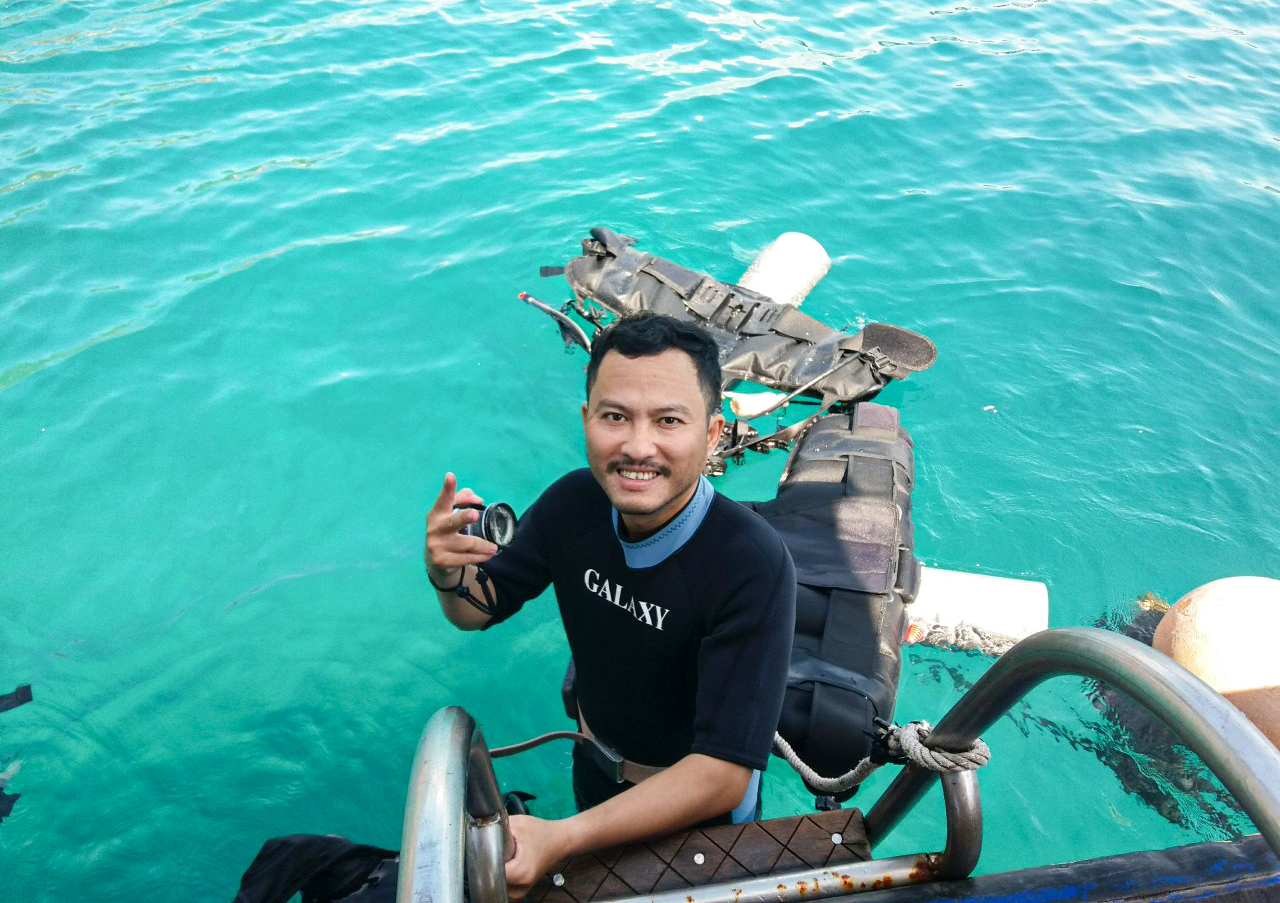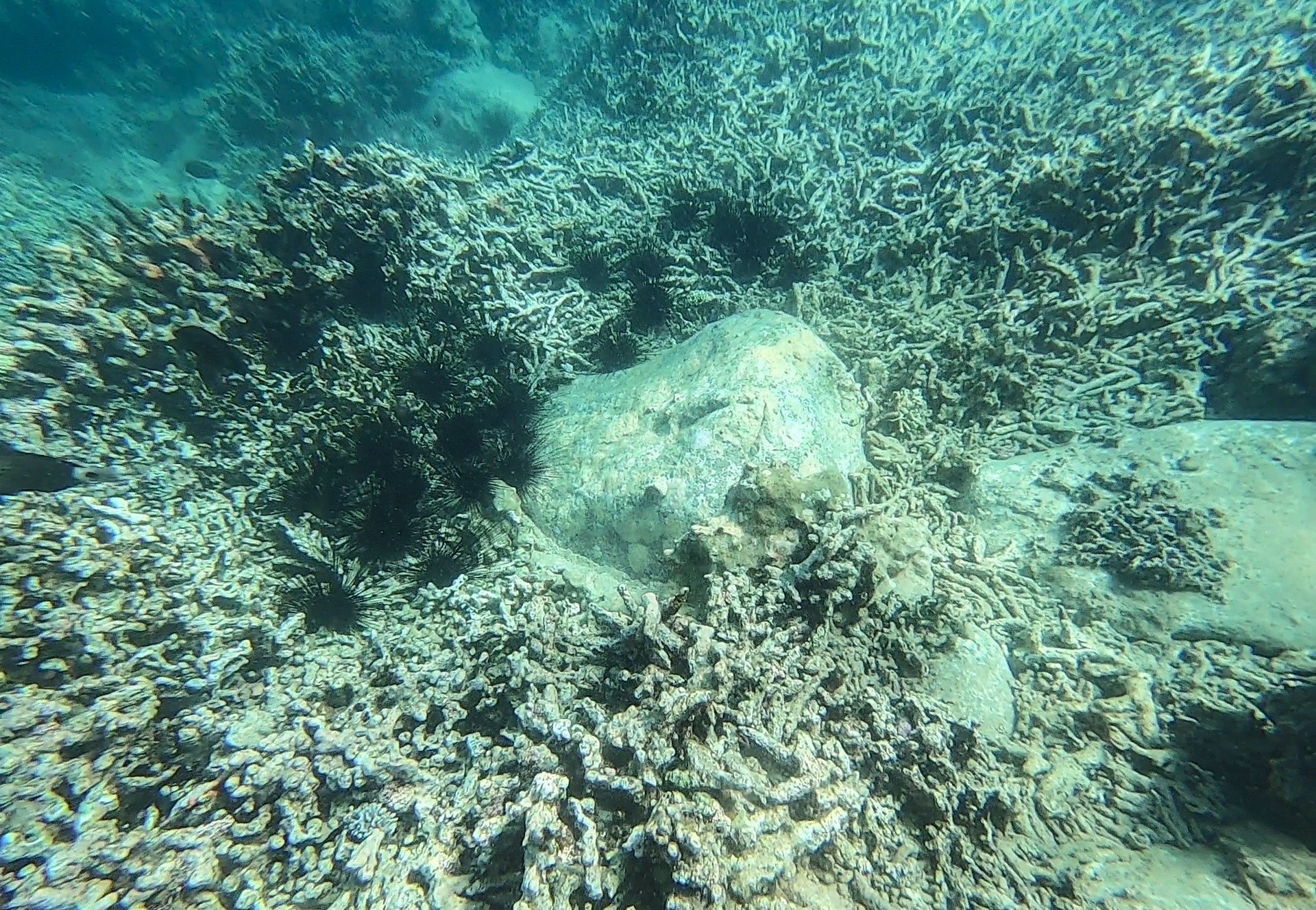Determined to see with my own eyes, to approach the place
“When the COVID-19 pandemic hit, I thought it was the best opportunity for the Nha Trang Bay Marine Protected Area, including the coral reefs. Many years ago, the Hon Mun core area was considered to have the most beautiful coral ecosystem in Vietnam. Now I was quite surprised because when I dived down, I witnessed the mass death of corals, it was very painful,” author Le Xuan Hoat opened the 5-part series “Nha Trang Bay Marine Protected Area Calls for Help” with the sharing of a guide with 20 years of diving experience in this place.
The seabed of the Hon Mun conservation area is thousands of square meters wide and white, without a single strand of coral, just a few small fish; and on the shore, piles of dead coral, stretching hundreds of meters, are the same image that haunted reporter Xuan Hoat for a long time after the series of articles was completed.

Reporter Le Xuan Hoat said he always values his work and tries to complete his work to the best of his ability. Source: NVCC
Nha Trang Bay Marine Reserve includes islands such as Hon Mun, Hon Tre, Hon Mieu, Hon Tam, Hon Mot, Hon Cau, Hon Vung... and surrounding waters. The total area is about 160km2 , including 122km2 of water around the islands. Nha Trang Bay currently has about 15 diving spots around the island. Most of these diving spots have many corals, rich and diverse ecosystems. Of which, the most beautiful and diverse is around Hon Mun area - the core area of the reserve, so diving must be permitted by Nha Trang Bay Management Board. At Hon Mun, famous diving sites include Hon Rom or Madonna Rock, Madam Hanh Beach, Coral Garden Beach, Southbay Beach or Fishing Men...
“This reserve has been strictly protected for decades. Therefore, when I heard the news that corals in the core area were dying en masse, at risk of being completely bleached for unknown reasons, I found it hard to accept, so I decided to go see it with my own eyes and approach it,” said author Le Xuan Hoat.
With only a week to spare, the male reporter of ZingNews electronic magazine was concerned about how to approach the scene “as quickly and thoroughly as possible” . In the Nha Trang Bay marine reserve, corals live at an average depth of 1.5m to more than 12m. Therefore, to observe with your own eyes, you need a shirt, hat, snorkel, diving tank… - professional equipment that the reporter does not have. Once you have specialized equipment, you need diving skills - something that the reporter has never been trained in.
If the depth is 1.5m to more than 2m, diving is very easy. But if you want to dive more than 5-6m or even more than 10m, first-time deep divers must be trained and have an instructor to accompany them, otherwise it is very easy to have incidents related to water pressure when diving deep.
“Diving deep to observe and take pictures of the seabed is a must when carrying out this project. Fortunately, I had the enthusiastic support of a number of diving instructors and diving experts in Nha Trang during my work at the seabed at a depth of nearly 15m,” said reporter Xuan Hoat.
Along with that, this is a topic that requires knowledge about ecosystem diversity, especially coral. Hoat was fortunate to have approached and talked a lot with oceanographers , especially Associate Professor Dr. Nguyen Tac An - former Director of the Institute of Oceanography.
“I learned most of my knowledge about marine ecosystem diversity and the living mechanisms of corals from Associate Professor Dr. Nguyen Tac An, who is known as the “old man of the sea,” Xuan Hoat shared.
In addition, while writing this series of articles, the author also had to consult a lot of knowledge from diving experts who have been attached to Nha Trang Bay in general and the coral ecosystem in the core area of Nha Trang Marine Reserve in particular for decades.
Responding to the call for help from Nha Trang Bay Marine Protected Area
After the series of articles "Nha Trang Bay Marine Protected Area Calls for Help" by ZingNews and the joint reflection of many other press agencies, on June 22, 2022, the Standing Committee of Khanh Hoa Provincial Party Committee requested the Party Committee of the Provincial People's Committee and the leaders of the Provincial People's Committee to direct the People's Committee of Nha Trang City to temporarily suspend diving tourism activities in areas that can easily damage coral reefs in the Nha Trang Bay area, especially in the Hon Mun area.

Dead coral in Hon Mun island area - core area of Nha Trang Bay marine reserve. Source: NVCC
Authorities also directed the demarcation of sensitive areas showing signs of ecosystem recovery (typically coral reefs and breeding grounds) in Nha Trang Bay. The Standing Committee of Khanh Hoa Provincial Party Committee assessed that the decline of most coral reefs in Hon Mun Marine Reserve is a process of cumulative impacts over many years, including both objective and subjective causes. Accordingly, the objective causes leading to the above-mentioned decline of coral reefs are the impact of climate change, the impact of Typhoon Damrey in 2017 and Typhoon No. 9 in 2021 (without ocean acidification).
Meanwhile, subjective causes come from management work, coordination between relevant departments, branches, localities, and activities of Nha Trang Bay Management Board, which still have many shortcomings, limitations, and shortcomings; many human activities affecting the marine ecosystem of Nha Trang Bay in general and coral reefs in Hon Mun Marine Reserve in particular have not been handled promptly (illegal fishing, dredging, construction of coastal works in violation of regulations, discharge of waste from tourism activities...).
“Nha Trang Bay is one of the 29 most beautiful bays in the world. It is no longer the property of Khanh Hoa province alone but of the whole world. We need to protect the ecosystem here. Tourists from everywhere come to Nha Trang because the bay is beautiful and the sea water is clear. If the coral dies, the marine ecosystem will also disappear. Meanwhile, it takes decades, even hundreds of years, to form a coral ecosystem, but just one month or one year of “forgetting” will make all those efforts go down the drain. If we do not take conservation seriously, in just a short time the natural “heritage” in Nha Trang Bay will no longer exist. And the consequences will certainly not be small,” reporter Xuan Hoat said emotionally.
Having alerted the authorities to take action after a series of dedicated articles, author Le Xuan Hoat further promoted the mission of reporters in dissecting and reflecting to find the source and solutions to urgent social problems.
“I always value my work and try to complete my work to the best of my ability. To do that, I need to constantly search for information on social platforms and documents; create more social relationships in all fields; learn from colleagues or read many newspapers, which can also be ways to explore new things; better grasp the issues that have happened and are happening in society,” the male reporter shared with a lot of passion for the profession.
Ky Hoa
Source






![[Photo] Students of Binh Minh Primary School enjoy the full moon festival, receiving the joys of childhood](https://vphoto.vietnam.vn/thumb/1200x675/vietnam/resource/IMAGE/2025/10/3/8cf8abef22fe4471be400a818912cb85)
![[Photo] Prime Minister Pham Minh Chinh chairs meeting to deploy overcoming consequences of storm No. 10](https://vphoto.vietnam.vn/thumb/1200x675/vietnam/resource/IMAGE/2025/10/3/544f420dcc844463898fcbef46247d16)































































































Comment (0)